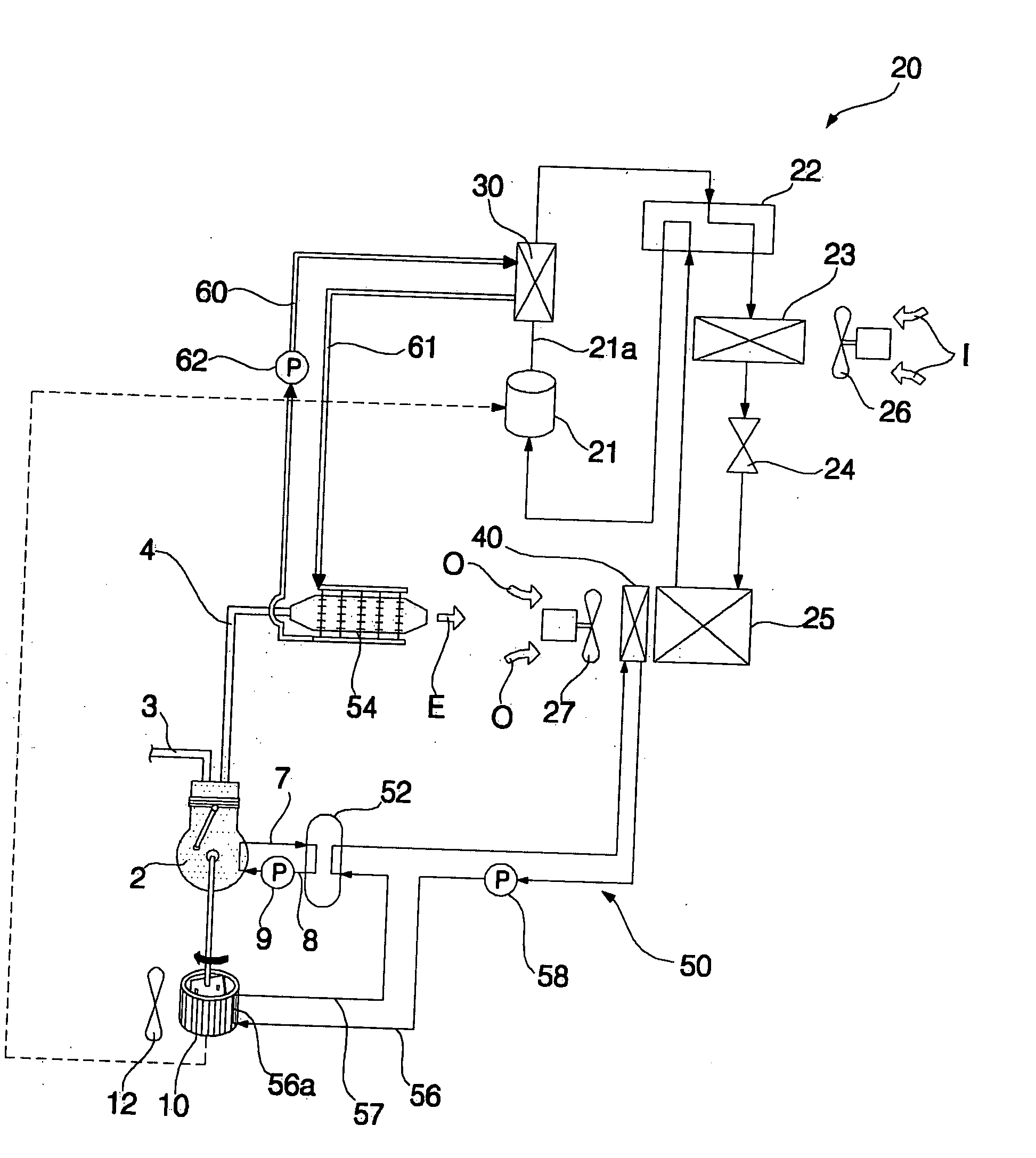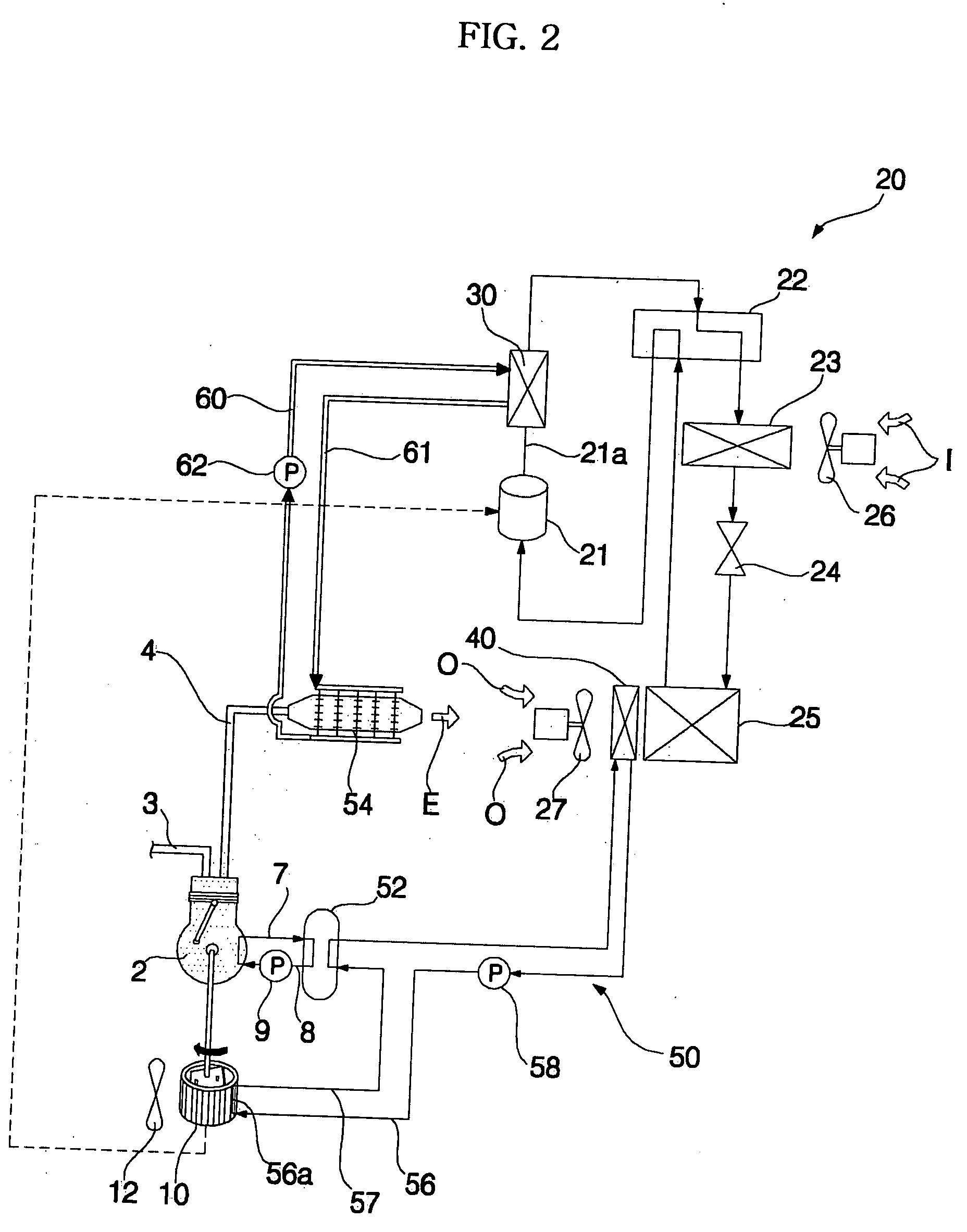Cogeneration system
a cogeneration system and energy efficiency technology, applied in the field of cogeneration systems, can solve the problems of limited enhancement of system efficiency, inefficient re-use of generator waste heat, and increase of noise, so as to prevent the frosting of outdoor heat exchangers, and enhance the energy efficiency of cogeneration system
- Summary
- Abstract
- Description
- Claims
- Application Information
AI Technical Summary
Benefits of technology
Problems solved by technology
Method used
Image
Examples
first embodiment
[0036]FIG. 1 is a schematic diagram of a cogeneration system according to the present invention.
[0037] As shown in FIG. 1, the cogeneration system includes an engine 2, a generator 10 connected to an output shaft of the engine 2 to generate electricity, and a waste heat recovering means 40 to recover waste heat of the generator 10, and to transfer the recovered waste heat to a heat consumer 20.
[0038] The engine 2 includes a combustion chamber defined in the interior of the engine 2.
[0039] A fuel tube 3 and an exhaust tube 4 are connected to the engine 2. The fuel tube 3 is adapted to supply fuel such as liquefied gas or liquefied petroleum gas into the combustion chamber. The exhaust tube 4 is adapted to guide exhaust gas discharged from the combustion chamber.
[0040] The generator 10 may be an AC generator or a DC generator.
[0041] The electricity generated from the generator 10 is used in various electrical devices 11 such as electric lamps and in the heat consumer 20.
[0042] Th...
second embodiment
[0096] The operations of the first and second heat medium circulation pumps 58 and 62, and the enhancement of the heating performance of the indoor heat exchanger 23 and the effect of defrosting the outdoor heat exchanger 25 respectively achieved by those operations are the same as those of the second embodiment, so that no detailed description thereof will be given.
[0097] When the heat pump type air conditioner 20 operates in the cooling mode, the controller 80 controls the control valve 76 to open the exhaust conduit 72 and to close the branched conduit 74.
[0098] In this case, exhaust gas E discharged from the engine 2 is guided to the exhaust gas heat exchanger 54 via the exhaust conduit 72, and is then discharged to the atmosphere after releasing its heat into the exhaust gas heat exchanger 54, as shown in FIG. 6. The exhaust gas heat exchanger 54 releases the heat absorbed from the exhaust gas to the atmosphere.
fourth embodiment
[0099]FIG. 7 is a schematic diagram of a cogeneration system according to the present invention.
[0100] As shown in FIG. 7, the cogeneration system includes a plurality of engines 2, 2′ . . . . The cogeneration system also includes a plurality of generators 10, 10′ . . . connected to respective shafts of the engines 2, 2′ . . . . The cogeneration system of the second embodiment has the same configuration and functions as those of the second and third embodiments, except for the engines 2, 2′ . . . and generators 10, 10′ . . . . Accordingly, the constituent elements of the fourth embodiment respectively corresponding to those of the first and second embodiments are designated by the same reference numerals, and no detailed description thereof will be given.
[0101] One or more of the engines 2, 2′ . . . operate in accordance with the load to be cooled or heated.
[0102] Fuel tubes 3, 3′ . . . and exhaust gas tubes 4, 4′ . . . are connected to respective engines 2, 2′ . . . . Exhaust con...
PUM
 Login to View More
Login to View More Abstract
Description
Claims
Application Information
 Login to View More
Login to View More - R&D
- Intellectual Property
- Life Sciences
- Materials
- Tech Scout
- Unparalleled Data Quality
- Higher Quality Content
- 60% Fewer Hallucinations
Browse by: Latest US Patents, China's latest patents, Technical Efficacy Thesaurus, Application Domain, Technology Topic, Popular Technical Reports.
© 2025 PatSnap. All rights reserved.Legal|Privacy policy|Modern Slavery Act Transparency Statement|Sitemap|About US| Contact US: help@patsnap.com



